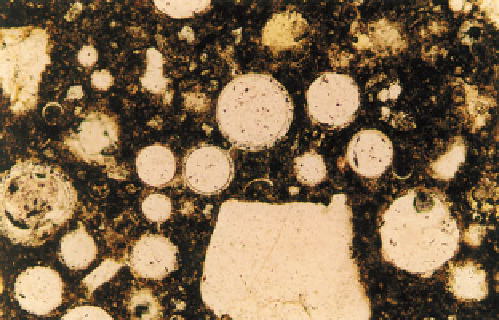Geoscience Reference
In-Depth Information
M
IX PROPORTIONS
The standard wet chemical analysis involving acid
dissolution, for example in accordance with the BS 4551
method (British Standards Institution, 2005a) or the ASTM
C1342 method (ASTM International, 2005b), is unlikely to
be accurate for specialist mortars. These methods do not
take into account the potentially high contents of mineral
additions, calcite fillers, and organic polymers. As a more
accurate alternative, mix proportions can be determined
petrographically by point-counting the aggregate/cement/
void ratio, either in thin section or polished specimen.
received in the laboratory, an initial visual and low-power
microscopical examination is conducted to determine the
number of material types or layers, layer thickness, colour,
and the relative hardness, coherence, and bond strength (in
qualitative terms). High-power examination of thin section
specimens is then used to determine the grading and
mineralogy of any aggregate, binder type, the presence of
mineral additions/fillers/ fibres, and to screen the material
for evidence of defects or deterioration.
The analysis of specialist mortars presents a substantial
challenge owing to the wide range of both inorganic and
organic ingredients used. Some ingredients that may
comprise less than 1% of the mix and are difficult to detect
can have a profound influence on mix properties.
One approach is use separate techniques for the
inorganic from the organic ingredients. Optical microscopy
is usually most appropriate for the inorganic components,
supplemented by scanning electron microscopy if required.
Minerals that are difficult to distinguish optically may be
readily identified by XRD. Infrared spectrophotometry is
the most appropriate method of chemical analysis for
identifying organic components. Provided that the correct
solvent is used to extract the desired organic species from
the sample, this technique can rapidly determine the
generic organic materials type and provide clues for the
next stage of analysis. Pyrolysis-gas chromatography, gas-
liquid chromatography, and ultraviolet spectrophotometry
can all be used as complementary or stand alone analytical
techniques for isolating a specific organic ingredient (Hunt
& Everitt, 2001).
E
XAMPLES OF SPECIALIST MORTARS
The examples below are not intended to be a
comprehensive review of mortars for specialist
applications. Instead, selected materials have been used
to illustrate the range of ingredients that are likely to be
encountered in specialist mortars.
Figures
326
and
327
show a proprietary repair mortar
for concrete. It consists of fine (1.18 mm nominal
maximum sized) quartz fine aggregate bound by Portland
cement with polymer modification, a PFA mineral
addition, calcite dust filler, and polypropylene
microfibres. Figures
328
and
329
show a proprietary
mortar designed for setting fastenings in concrete. It
consists of 600 μm nominal maximum sized, quartz fine
aggregate bound by epoxy resin and Portland cement.
Figure
330
shows a proprietary grey-coloured
cementitious tile adhesive. It consists of quartz sand fine
aggregate, bound by Portland cement with a calcite dust
filler and latex bonding agent. Figures
331
and
332
show a brown-coloured cementitious tile adhesive,
comprising a mixture of Portland cement and calcium
326
327
326
Proprietary repair mortar for concrete, showing
fine aggregate particles (white) and cement matrix
(dark brown) with PFA (white spheres); PPT, ×150.
327
A cluster of polypropylene fibres (brightly
coloured) within a proprietary repair mortar for
concrete repair; XPT, ×150.






